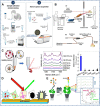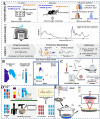Raman and fourier transform infrared spectroscopy techniques for detection of coronavirus (COVID-19): a mini review
- PMID: 37273513
- PMCID: PMC10232992
- DOI: 10.3389/fchem.2023.1193030
Raman and fourier transform infrared spectroscopy techniques for detection of coronavirus (COVID-19): a mini review
Abstract
Coronavirus pandemic has been a huge jeopardy to human health in various systems since it outbroke, early detection and prevention of further escalation has become a priority. The current popular approach is to collect samples using the nasopharyngeal swab method and then test for RNA using the real-time polymerase chain reaction, which suffers from false-positive results and a longer diagnostic time scale. Alternatively, various optical techniques, namely, optical sensing, spectroscopy, and imaging shows a great promise in virus detection. In this mini review, we briefly summarize the development progress of vibrational spectroscopy techniques and its applications in the detection of SARS-CoV family. Vibrational spectroscopy techniques such as Raman spectroscopy and infrared spectroscopy received increasing appreciation in bio-analysis for their speediness, accuracy and cost-effectiveness in detection of SARS-CoV. Further, an account of emerging photonics technologies of SARS-CoV-2 detection and future possibilities is also explained. The progress in the field of vibrational spectroscopy techniques for virus detection unambiguously show a great promise in the development of rapid photonics-based devices for COVID-19 detection.
Keywords: ATR-FTIR; COVID-19; FTIR spectroscopy; Raman spectroscopy; SERS; diagnostics.
Copyright © 2023 Zhang, Zhao, Qi, Zhang and Tian.
Conflict of interest statement
The authors declare that the research was conducted in the absence of any commercial or financial relationships that could be construed as a potential conflict of interest.
Figures


Similar articles
-
Optical technologies for the detection of viruses like COVID-19: Progress and prospects.Biosens Bioelectron. 2021 Apr 15;178:113004. doi: 10.1016/j.bios.2021.113004. Epub 2021 Jan 16. Biosens Bioelectron. 2021. PMID: 33497877 Free PMC article. Review.
-
Diagnostic performance of attenuated total reflection Fourier-transform infrared spectroscopy for detecting COVID-19 from routine nasopharyngeal swab samples.Sci Rep. 2022 Nov 27;12(1):20358. doi: 10.1038/s41598-022-24751-z. Sci Rep. 2022. PMID: 36437268 Free PMC article.
-
Photonics of human saliva: potential optical methods for the screening of abnormal health conditions and infections.Biophys Rev. 2021 Jun 2;13(3):359-385. doi: 10.1007/s12551-021-00807-8. eCollection 2021 Jun. Biophys Rev. 2021. PMID: 34093888 Free PMC article. Review.
-
The Potential of Optical Technologies in Early Virus Detection; Prospects in Addressing Future Viral Outbreaks.Crit Rev Anal Chem. 2025 Mar 27:1-29. doi: 10.1080/10408347.2025.2481406. Online ahead of print. Crit Rev Anal Chem. 2025. PMID: 40146886 Review.
-
Spectroscopy: a versatile sensing tool for cost-effective and rapid detection of novel coronavirus (COVID-19).Emergent Mater. 2022;5(2):249-260. doi: 10.1007/s42247-022-00358-y. Epub 2022 Feb 28. Emergent Mater. 2022. PMID: 35252760 Free PMC article. Review.
Cited by
-
The application of vibrational spectroscopy in forensic analysis of biological evidence.Forensic Sci Med Pathol. 2025 Mar;21(1):406-416. doi: 10.1007/s12024-024-00866-9. Epub 2024 Aug 24. Forensic Sci Med Pathol. 2025. PMID: 39180652 Review.
-
Perspectives of FTIR as Promising Tool for Pathogen Diagnosis, Sanitary and Welfare Monitoring in Animal Experimentation Models: A Review Based on Pertinent Literature.Microorganisms. 2024 Apr 20;12(4):833. doi: 10.3390/microorganisms12040833. Microorganisms. 2024. PMID: 38674777 Free PMC article. Review.
References
-
- Barauna V. G., Singh M. N., Barbosa L. L., Marcarini W. D., Vassallo P. F., Mill J. G., et al. (2020). Ultra-rapid on-site detection of SARS-CoV-2 infection using simple ATR-FTIR spectroscopy and analysis algorithm: High sensitivity and specificity. Prepr. Public Glob. Health 93, 2950. Available at:. 10.1101/2020.11.02.20223560 - DOI - PubMed
Publication types
LinkOut - more resources
Full Text Sources
Miscellaneous

